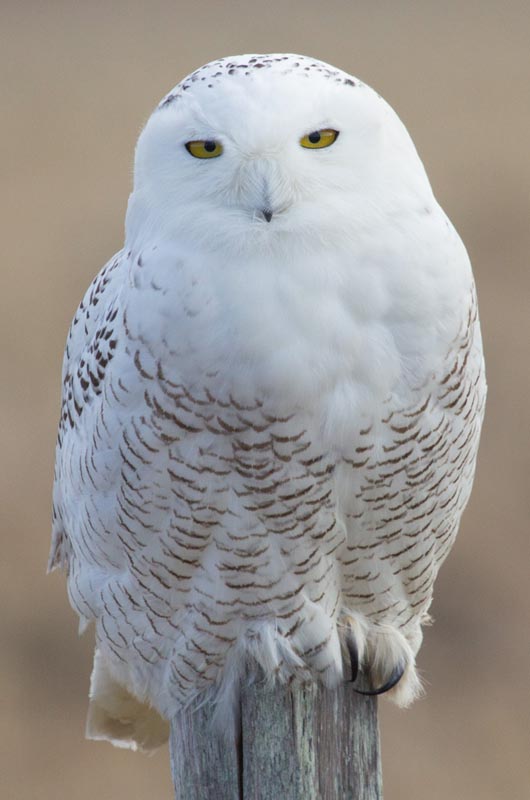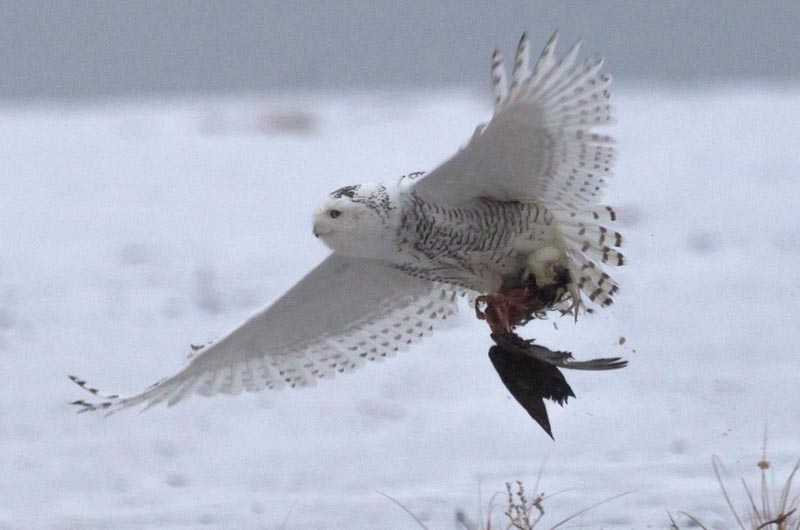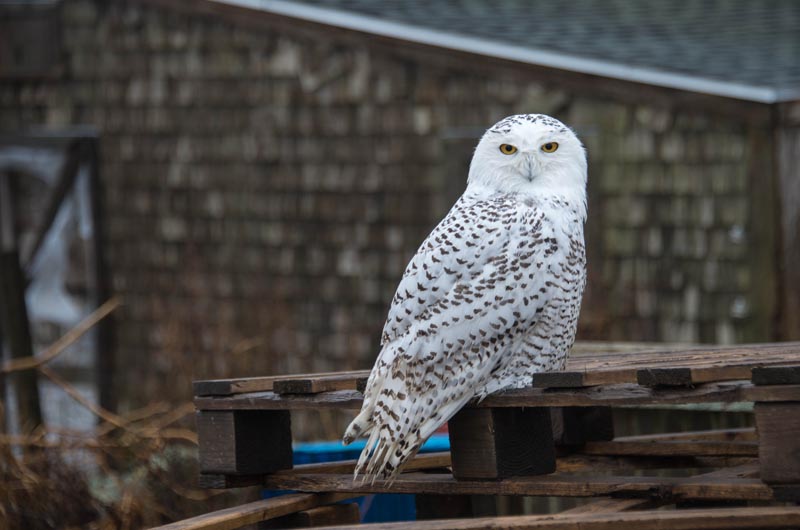In the Arctic, snowy owls’ natural predators are polar bears and Arctic foxes. On Martha’s Vineyard this winter, they are being stalked by people with cameras.
The large, regal white birds with big yellow eyes have been spotted in unusually large numbers throughout the eastern seaboard this year, including on the Vineyard, where beaches and open habitat resemble the owls’ native Arctic tundra. The irruption of snowy owls has led to sightings from Norton Point to Aquinnah, delighting amateur birders and ornithologists alike. Despite the abundance of snowy owl pictures and sightings, biologists say there’s still a lot of mystery about the visitors from the north, including why so many of them are here.
“This is a record number for sure,” said Norman Smith, the sanctuary director of Mass Audubon’s Blue Hills Trailside Museum. He’s been tracking snowy owls for more than 30 years, and started a project to track and relocate the owls from Logan Airport. “It’s amazing the volume of birds that are coming through.”
As of Jan. 23, Mr. Smith had captured 68 snowy owls at Logan Airport this winter, the largest number in 32 years. In other years, the average was six to eight owls.
The annual Christmas bird count on Jan. 4 found nine snowy owls on the Vineyard, but members of the Vineyard birding community suspect there were more. The bird count on Nantucket tallied 33 snowy owls.
Island naturalist Gus Ben David said that by his estimate, there were up to 20 to 25 snowy owls on the Vineyard this year.
“That’s the highest that’s ever been recorded,” he said, adding that three weeks ago, he saw 12 snowy owls in one day on Chappaquiddick. Some years there no sightings reported, he said, while there are usually one or two.
It isn’t clear why the owls are arriving in such large numbers, but there are some theories, Mr. Smith said. One is that in some years there is an abundance of food in the Arctic, which in turn leads the owls to have productive breeding seasons and produce more owlets. These owls in turn travel further south to find food.
Mr. Smith said snowy owls only breed when there are adequate lemmings available and, as it turns out, last summer was a good year for lemmings in northern Quebec. The owls arriving are in good condition, he added.
Most of the owls that are part of the southern irruption have been young, Mr. Smith said, usually less than a year old. Younger owls usually have darker plumage.
Mr. Smith said that adults could be pushing the younger owls out, causing them to disperse to find their own space.
The birds seek out habitat that is similar to the tundra. On the Vineyard, they’ve been spotted on beaches and dunes, and they seem to frequent Katama, including the Farm Institute and Katama Airfield.
Snowy owls are also drawn to Logan Airport, leading to Mr. Smith’s project to trap and relocate the owls for the safety of the owls and the planes.
The birds are captured and then weighed and checked for parasites. Their wings and tails are also measured. This information is entered into a database to compile more information about the owls and their habits, and satellite transmitters are attached that measure things like location and the bird’s body temperature.
Transmitters attached to some of the owls show wide migration patterns, Mr. Smith said. Two years ago a snowy owl released from Plum Island flew all the way north to Nunavut, in northern Canada. The bird returned to Logan Airport, traveling 7,000 miles in one year.
This year, snowy owls have been seen as far south as Florida and Bermuda, Mr. Smith said.
While snowy owls have coats of feathers that allow them to withstand temperatures as frigid as 80 degrees below zero, Mr. Smith said the coat also allows them to stay cool when it gets warmer.
The birds are mostly nocturnal, he said, but also hunt in the daylight. After all, they hail from the Arctic, where it doesn’t get dark part of the year.
Besides lemmings, they hunt for rodents, muskrats, skunks and all sorts of bird species, Mr. Smith said, including sparrows, waterfowl, Great Blue Herons, other owls and even Peregrine falcons.
“Here on the Vineyard they take gulls,” Mr. Ben David said. “They are opportunists and they’re very fast. As big as they are, they’re one of the fastest owls on the wing.” “
Mr. Ben David once rehabilitated a snowy owl, he said, and the irruption of owls has let others observe them, too. “
It’s been wonderful,” he said. “So many people have been able to see them and get fairly close to them.”
Because many of the owls that come south are the young of the year, Mr. Smith said, a good portion will not survive and make it back to the Arctic.
“Nature is cruel,” Mr. Smith said. “It’s very difficult to grow up and be an adult.” Causes of death include a lack of food and also parasites, planes and cars, poison meant for rodents, and electrocution. He said 13 snowy owls have been found dead in Massachusetts this winter, and of them five were hit by planes and two had been poisoned by rodent poison.
Some will survive, Mr. Smith said, and some will even return south in future years.
The snowy owl is not listed as endangered or threatened, Mr. Smith said, but it also isn’t clear what their status is. Some estimates place the population at about 300,000, he said, but there isn’t anybody in the Arctic to do a systematic survey. “We don’t know if [the population is ] increasing or decreasing,” he said.
But the snowy owl is “an indicator species of how the Arctic is doing,” he added. “Whatever affects snowy owls we should investigate and look at, because whatever affects snowy owls is going to affect us in the future.”
While they are here, the snowy owls have quickly become one of the most photographed creatures on the Island, and the talk of the birding community.
“They are a bird that’s white, big, comes from the Arctic,” Mr. Smith said.
Others credit Hedwig, Harry Potter’s faithful messenger, for the popularity of the species.
Lanny McDowell, a painter and avian photographer, said he remembers the date the first snowy owl arrived on the Vineyard this year: November 29. Mr. McDowell was in Africa but heard the news via email. When he arrived home on the Vineyard, he soon had his own sightings at Norton Point and Quansoo.
“Reports were coming in from all over the Island,” Mr. McDowell said, adding that you can’t talk about snowy owls without also talking about their occasional irruptions.
The birds caused a flurry of activity on Martha’s Vineyard Bird Alert, a Facebook group, with photographs and reports of sightings.
“The pictures are so iconic, it’s sort of hard to resist,” Mr. McDowell said. “People are still talking about going out with the purpose of finding one.”
As for all those photos, Mr. Smith said infrequent disruptions might be okay for the owls, but being frequently disturbed by humans prevents them from roosting during the day.
“Look at the bird’s posture,” he said. “The bird will tell you when you’re getting too close . . . if the bird starts to get anxious and starts to be wide awake, turning its head and stretching its wings,” then you are too close. “Try to give them as much space as possible and let them do their thing.”
“I’ve basically been stalking them, I guess,” said Jeff Bernier, a photographer who has captured hundreds of snowy owl pictures, including a picture of a snowy owl that caught a crow. “This is the first year I’ve seen one.”
“It’s a real novelty and the whole idea, why now, why all over the East Coast? It brings up all those questions which are kind of fun to investigate,” Mr. Bernier said. “They’re fun to photograph because they stand out and they’re big . . . the photography is much more forgiving because they’re such great subjects.”
They also come in the right season, ornithologist and Gazette bird columnist Susan Whiting said.
“They are unusual, beautiful and they are a great distraction in the winter months.”










Comments (1)
Comments
Comment policy »